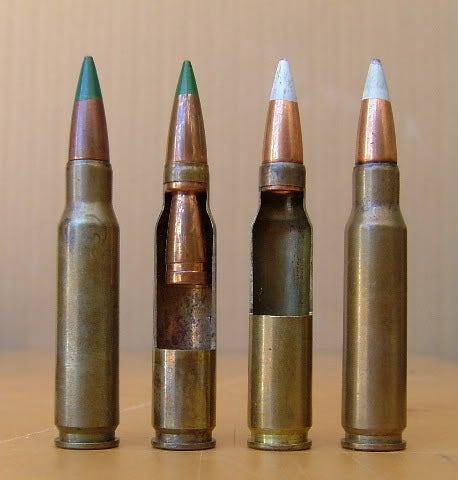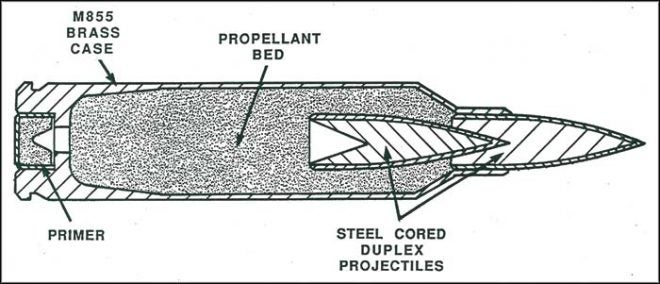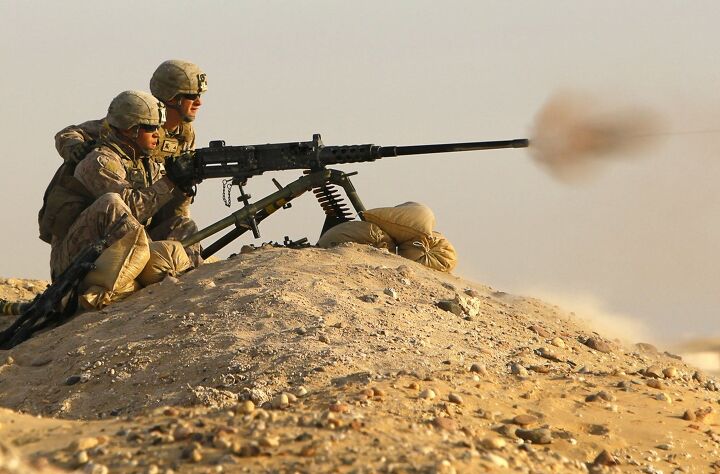The concept of stacking projectiles on top of each other inside a self-contained cartridge dates back to the 19th century. It has subsequently been revisited dozens of times by arms designers from all over the world. In the 1950s the US Military experimented with duplex (two projectiles) and multiplex (multiple projectiles) cartridges during Project SALVO. This experimentation eventually led to the creation of the 7.62x51mm M198 Duplex round.
The M198 round was standardised in 1964, and tests found it increased hit probability by up to 75% on a man-sized target at the ranges out to 500m. Despite this the round was dropped in the late 1960s. Some online sources suggest that M198 did not improve hit probability as much as had been hoped, with the suppressive potential of the round also undermined by the projectile design’s inherent accuracy which minimised hit dispersion.

7.62mm M198 Duplex, far left, along with its single bullet counterpart, the XM256E1 Low Recoil round, and sectioned examples of each. Image from Ray Meketa’s collection.
In the 1960s Colt also experimented with multiplex rounds, developing the Colt Salvo Squeeze Bore which coupled the multiplex projectiles with a tapered barrel. The US Army incorporated Colt’s developments into Project Agile and tests with smoothbore M2 Brownings rechambered in .50/30 SSB rounds were carried out. The US military lost interest in the project as the Vietnam War came to an end.
More recently during the US Army’s Advance Combat Rifle program in the late 1980s saw Colt develop a new 5.56x45mm duplex round for use in their ACR entry. These rounds were developed by the Olin Corporation which had a long background in the development of multiplex ammunition, dating back to Project SALVO. The round had two projectiles placed nose to tail with copper jacketed steel penetrators. In theory the lead projectile would strike at point of aim while the second would strike somewhere near point of aim with in a theoretically limited area of dispersion. Quality control with the rounds was lacking, however, and a projectile lodged in the barrel during testing causing the barrel to burst.

Colt/Olin 5.56x45mm Duplex round Developed for Colt ACR (US Army)
It appears that once again the US military is exploring the use of multiplex projectiles. Christopher Parisi, ARDEC Armaments Project Officer, recently gave a presentation at the NDIA 2018 Armament Systems Forum on ‘Small Caliber Multiplex Technology’. The PowerPoint from his presentation has recently become available, in it we learn about some of ARDEC’s work on new duplex ammunition.
ARDEC have been using ‘cutting edge modeling and simulation’ as part of an iterative design process to develop a new multiplex round. It is hoped that the lessons learned from the project will enable ‘scalable multiplex cartridge technology’. The presentation states that the multiplex rounds have lower collateral damage, increased threat suppression and can be reconfigured for various applications.
We reached out to Parisi, a project officer with ARDEC’s Small Caliber Ammunition Development team, and he was kind enough to tell me more about ARDEC’s Small Caliber Multiplex Technology project. He explained the drive behind the project:
One of our methods of maintaining a tactical overmatch against the Enemy is to manipulate the battlefield… More specifically, certain Enemy targets, which are agile and difficult to neutralize, have flourished in the last few years. ARDEC has been designing, building and testing small caliber multiplex prototypes since 2011.
Parisi said the team have extensively tested the old M198 7.62mm Duplex cartridge as part of their research and stated that contrary to popular belief the Army probably dropped it due to the round’s reduced penetration capabilities and potential logistical issues.
ARDEC have been working on the multiplex project for around 7 years and Parisi confirmed that testing has been carried out at ARDEC’s state-of-the-art 300m indoor range, at Picatinny Arsenal, using precision instrumentation, as well as some laboratory testing and live-fire mission simulations at Eglin Air Force Base, China Lake, Point Mugu, Fort Dix and Yuma Proving Ground.

A still from high speed footage showing a multiplex round just after leaving the muzzle. – Sadly there are no photos of the new XM1175 round available. (Courtesy of ARDEC)
ARDEC have developed a .50 calibre full-bore duplex round, the XM1175 ‘Interceptor’, this round was designed to be used in all existing M2 heavy machine guns. This means the new ammunition could be used in vehicle mounted M2s or in perimeter defence, in theory any M2, deployed on land, sea or air, could utilise the round.
One of the advantages of the new round is that it can be employed in situations where collateral damage is an issue. The lower mass and the nature of the XM1175’s aeroballistics means that the round will decelerate more rapidly and cause less damage to objects it hits, creating what ARDEC describe as a Smaller Surface Danger Zone (SDZ), giving troops more engagement opportunities in closer quarters.
Parisi explained that “while the technology we have developed is caliber-agnostic, most of our work has been in caliber .50 due to widespread use of the M2 machine gun and the suitability of the two systems for the given mission set.” ARDEC hope the XM1175 will see service in the near future, but in the meantime they are continuing development of small caliber multiplex technology.
Sources:
‘Small Caliber Multiplex Technology’ NDIA 2018 Armament Systems Forum Presentation, retrieved 12/06/18 from source
My thanks to Chris Parisi.
H/T: Dan Watters
 Your Privacy Choices
Your Privacy Choices
